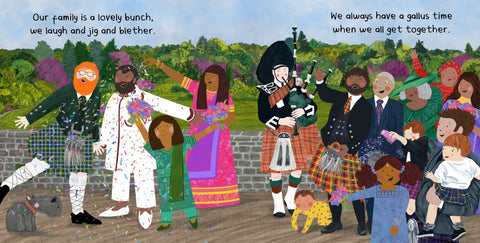Here’s why I decided to feature a gay wedding in my children’s picture book…
At nursery drop-off this week I bumped into one of the dads who had pre-ordered 10 copies of My Family is So Scottish. That’s right, ten copies! He’s keeping one for his kids and gifting the rest to friends and family. I asked why he bought so many and he said something I hadn’t realised…

First off, let’s talk about incidental representation and why it is so important for children’s books.
Incidental representation is where marginalised identities such as religion, ethnicity, race, sexuality, gender, disability, are represented in a book where the book is not specifically centred around this identity.
Can you think of any children’s books that include an LGBTQ+ character that isn’t about having same-sex parents? Or one featuring a disabled child but not about their disability? Where is religious representation in non-religious books?
Many of you reading this will agree that representation in children’s books matter, so that every child gets to see themselves in the pages they read. It is also important for all children to see more of this in their own books, so that things like gay marriage isn’t taboo.
When I decided to include a wedding at the end of my book to show the family having a gallus time, I first thought of my own. Because my husband’s family is Bangladeshi and mine Scottish we had an explosion of colour with kilts, sarees and a mash-up of music when it came to the end of night dancing.
Our multi-cultural wedding
I wanted to re-create this joy and as I was looking at these pictures to send as a reference for Karen, I thought: why not have two uncles marry…
It was one of the best decisions I made. The two wedding pages - the ceremony and the party - emanate joy and celebration.

So let’s get back to my conversation at the nursery doorstep.
As a same-sex couple, this dad has quite a few books in his home about a family with two dads. But they all had two things in common:
-
They were aimed at very small children
-
They only really focused on the nuclear family of parents and their child(ren).
He said the fact that my book features a gay wedding celebration where the whole extended family are celebrating is something he hadn’t seen - let alone one of uncles (or guncles) rather than parents.
I hadn’t realised this, and that in itself is a problem. As a cis-woman in a relationship with a cis-man we didn’t actively seek out books about same-sex parents. In fact the only books we have that feature LGBTQ+ parents are those that are done so incidentally! (see recommendations below)
And here lies the reason why incidental representation is important: because the coverage is so much wider. Parents of disabled children don’t tend to buy books about disabled children. But if that representation is in every book, their children see more varieties of children playing and having adventures just like they do.
----------------------------------------------------
**Very important point for authors & publishers: If you are not from any minority background that you are including in your book it is vitally important that you have sensitivity editors throughout your process. See this video for more information on this.
----------------------------------------------------
Recommendations:
Listen to this podcast about incidental representation in children’s books
Read these books:
READY FOR AN ADVENTURE by Abbi-Jean Reid and Bhumika Jangid
BATHE THE CAT by Alice B. McGinty and David Roberts
JULIEN AT THE WEDDING by Jessica Love
GRANDDAD’S CAMPER by Harry Woodgate
MR WATSON’S CHICKENS by Jarret Dapier and Andrea Tsurumi
HARINI AND PADMINI SAY NAMASTE by Amy Maranvile and Tim Palin


